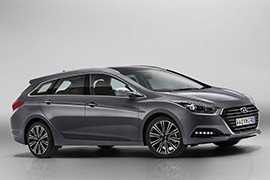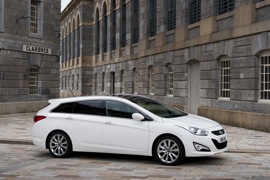HYUNDAI i40 wagon Models/Series Timeline, Specifications & Photos
First production year: 2012
Engines: Diesel, Gasoline
Body style: Wagon (station wagon, estate, combi, touring)
The updated version of the Hyundai i40 Wagon is a clear statement of the Korean manufacturer regarding the European market. It represents an alternative for the well-established D-segment station wagons. Their target was to build a vehicle with a touch of luxury at affordable prices. Its suspension was tuned for fast driving and installed with up to 18” light-alloy wheels on it.
The most important modifications were made under the hood, where Euro6d engines were installed. It offers gasoline and turbodiesel versions, with outputs ranging from 115 hp up to 178 hp, depending on the market. Standard gearboxes are 6-speed manuals and a 6-speed automatic with paddle shifters is offered as an option. A new, 7-speed DCT (dual-clutch) gearbox was available for the facelifted version, but only for the diesel units.
The platform is the same as for the Hyundai Sonata, with four-wheel independent suspension. The 2.77 m (109 in) wheelbase is fit for a spacious interior. The trunk space is 553 liters (19.5 cu.ft) and can be extended by folding the rear seats up to 1719 liters (60.7 cu.ft).
After it was released as a facelift, sales didn't go well and the vehicle was withdrawn from several markets, including Australia and U.K. For the sedan version, the Sonata took the market share from the i40.
In Europe, the station-wagon market was high, and almost every car manufacturer had something to say. Hyundai did it very well with the 2012 i40 Tourer.
Most of the station-wagon vehicles looked like they were drawn on a budget after the sedan version was launched. It wasn't the case with the i40 Tourer, a car that looked as good as a station-wagon as a sedan.
Like most of the station wagons on the market, the station-wagon looks the same up to the B-pillar with the sedan from which it derives. Then, a longer roof and an almost vertical tailgate end the vehicle. The i40 was not like that. The roof was slightly curved up and then extended to a raked rear end. It looked more like a sport-wagon than a station wagon. The sculptured side panels from the rear doors and the quarter-panels were specific to this model, not taken over from the sedan.
Inside, the i40 offered good legroom for the rear passengers but not limited headroom. It was not the case with the Tourer, which had even more legroom and offered big headroom. Three passengers could sit well in the back, thanks to an almost flat floor. For the rear-view camera, Hyundai didn't play the image on the central screen but within the rearview mirror. A three-piece panoramic roof was available. The front section tilted, the center section slid, and the rear fixed.
The engine variant was as wide as for the sedan. The top-selling version was a 1.7-liter turbodiesel, which could be mated to a 6-speed manual or a 6-speed automatic.

